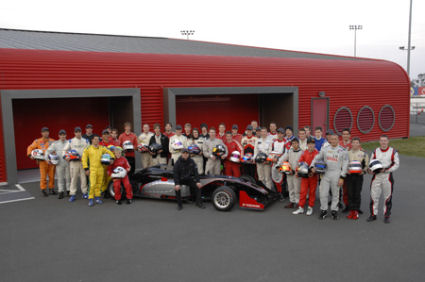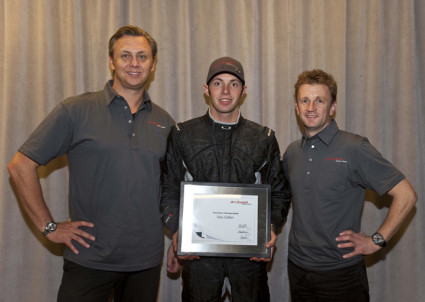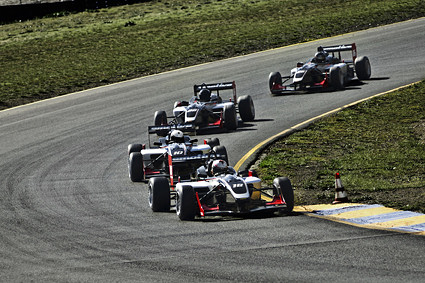The Way It Is/ Jim Russell's exciting new scholarship
by Gordon Kirby The Jim Russell Racing Drivers School at Infineon Raceway in California has initiated a new driver scholarship program to award a pair of funded rides each year in the Russell Championship Series. A four-day run-off to determine the inaugural prize winners for 2010 took place at Infineon just before Christmas and the two selected were Gary Carlton, 23, and Alex Ellis, 18. Carlton is an accomplished karter from Marysville, California, while the comparatively inexperienced Ellis hails from St Catharines, Ontario, Canada.
The Jim Russell Racing Drivers School at Infineon Raceway in California has initiated a new driver scholarship program to award a pair of funded rides each year in the Russell Championship Series. A four-day run-off to determine the inaugural prize winners for 2010 took place at Infineon just before Christmas and the two selected were Gary Carlton, 23, and Alex Ellis, 18. Carlton is an accomplished karter from Marysville, California, while the comparatively inexperienced Ellis hails from St Catharines, Ontario, Canada.
Carlton and Ellis earned themselves a full 2010 season in the Jim Russell Championship Series worth $129,000. The Russell series comprises sixteen races run on a variety of courses at Infineon Raceway from April through November. The second component to the Russell school's new scholarship program is a fully-funded Formula 2 drive in Europe in 2011 for the 2010 JRRDS champion.
"We'll also give our champion the support to go over there," says JRRDS president Chip Pankow. "We won't just give him a 'plane ticket and tell him, 'Good luck.'."
Renowned Audi LMP1 driving star and Le Mans winner Allan McNish has joined the Russell school as a consultant and McNish was chairman of the judging panel for last month's four-day driver search program.
"We're actively trying to develop the championship and the future driver program," McNish comments. "We want to create a clear platform. You've got to get on the ladder and there's not that many opportunities around right now. When I look around in Europe there's very little opportunity and when you look at America it's probably even harder. I think if you were to sit down and try to work your way through where you would take a young racing driver in America today, it's not so easy.

"So this program provides an opportunity to exploit the potential of the young drivers who are trying to find a way forward," McNish adds. "With the F2 ride as the plum it gives them a career direction. I think you've got to plan your way forward as well as you can and it's easy to get into the wrong environment. Having made the odd wrong turn and decision as a young driver, I've been through it, and I believe this program can be a great benefit to the sport."
The Formula Russell car is built by Lola Cars and is based on a 2007 Lola Formula 3 car. The Russell car is powered by a turbocharged 2.0 liter four-cylinder Mitsubishi Lancer Evo 9 engine that makes about 310 bhp.
"It's a serious car," Pankow observes. "Our car is kind of a Formula 3 car plus. It's not a detuned Formula 3 car. It's a proper car and has quite a bit more horsepower and torque than an F3 car."
"The car has the downforce and power to make it an ideal stepping stone," McNish adds. "I drove it after Petit Le Mans last fall. I spent a few days at Infineon and drove it in pretty much every condition, except the rain, and it's a lovely little car, very fast with plenty of horsepower."
JRRDS president Pankow believes scholarship winners Carlton and Ellis will show well in this year's Russell series.
"We're completely thrilled for both Alex and Gary," Pankow remarks. "They both did an amazing job and both deserve it. It was very close, but also a very clear choice."
Pankow, McNish and the other judges were very impressed with Carlton and Ellis.
"Gary Carlton was a huge surprise to us," Pankow says. "He turned the fastest individual lap and he had the least amount of experience of anybody. The final day was Gary's eleventh day in an open-wheel car, but he was absolutely dead solid. You would have thought it was his eleventh season in a formula car from the way he drove. He never went off, had very few brake lockups and he was very fast. He's an amazing talent."
Carlton has won a string of karting titles over the past six years and is ranked by many as the USA's number one karter. But Carlton doesn't have the financial backing to make the move into cars and before last month's Russell run-off he was planning to pack up and move to Italy to earn a living driving karts in Europe for Team CRG.

"If this didn't happen Gary was done with cars," Pankow observes. "He doesn't have much funding and he was planning to go race karts in Europe where he can earn a living."
"Gary was very impressive because he has so little car experience," McNish adds. "I made a lot of phone calls back to Italy to find out how his karting was and there was nothing but positive compliments about his skill and also about his personality which backed-up what we saw. And his speed in the car was clear."
Alex Ellis raced karts for three years and raced in last year's Formula BMW USA championship, taking one pole and finishing sixth in the series. Ellis was one of the least experienced contenders at last month's Russell scholarship run-off.
"Alex has very little experience overall in cars and karts but he has a great personality and took feedback well," Pankow relates. "He's clever and learned quickly and was brilliant in the car. In the wet sessions he was faster than anyone by a good margin and that told us he has a really good feel for the car.
"We also had really cold mornings and every session he did he was fast out of the box immediately. He knows how to drive the car on cold tires and that's such an important skill that's often overlooked. Over the space of a session he was ten seconds clear of everyone else because he made all that time in the first two or three laps. So he was really impressive.
"We weren't necessarily looking for the best driver on this particular day. We were looking for the driver that showed that best potential. Alex put in the third best single lap of the weekend. We selected Alex for the second seat based on his potential and his wet weather performance, his progression and his ability to take feedback."
Adds McNish: "Alex had an ability that you don't see very often. He was able to get in a new situation and within a couple of laps was up to speed, but not recklessly. He was very impressive in the wet and Infineon is not an easy track in the dry, let alone the wet in a car that you've never really put your foot into. That made him stand out for me as someone who's got that innate talent that can be developed, and he's such a personable lad. He's Mr. Bubbly Personality."
The thirty-eight young drivers came from ten countries.

"It was very international," Pankow says. "We're not looking for the fastest American. We're just looking for the best driver we can find."
The field of thirty-eight competitors was cut to eighteen after the second day and further culled to six finalists for the fourth day. The first of the four days was very busy with all thirty-eight young drivers running through a variety of different driving exercises, first in karts, then in Formula Russell cars.
"Most of them have very little, if any experience in cars," Pankow notes. "But most of them have a quite a lot of karting experience so we ran in them karts to assess their basic skills. It also shows us a lot about their racecraft."
Next came some familiarization runs with the Formula Russell car.
"We put them in the FJR50 for some braking and downshifting exercises to make sure they either had or developed the footwork skills necessary so they didn't hurt themselves, or the cars," Pankow notes. "It also gave them a chance to spend an hour in the car feeling the power and the braking and getting used to the aggressive braking that can be done with a little bit of downforce."
All thirty-eight drivers then moved to the track's skid pad.
"The third thing they all did was to run the FJR50 on the skid pad to see if they had a feel for the car," Pankow relates. "Could they detect understeer and oversteer and how comfortable were they doing reaction slides with the car?"
The opening day closed with some more driving exercises, this time in the Russell school's Mitsubishi road cars.
"The fourth exercise," Pankow says, "was to put them in our Mitsubishi Evolution 10 road cars and run them around our handling course through the paddock to see if they had a basic understanding of vehicle dynamics."
Day two was spent running timed laps on the track in both karts and Formula Russell cars.
"We timed them and could see what they looked like," Pankow remarks. "This was when we started to weed-out who was for real and who wasn't."

© N.Napierala Photography
The third day comprised a kart race with two qualifying heats and a final in the morning and an afternoon of running laps in the Formula Russell cars. It rained at Infineon on the third day, adding an extra element to the run-off. The Russell school runs a fleet of KTM karts powered by 125 cc Rotax engines and has a complete supply of rain tires for running in the wet.
"They all ran two heat races with transfer positions to the final and we about had a world championship karting race on our hands that morning!" Pankow remarks. "We had some real standout performances in the kart race. James Kovacic was absolutely amazing. He took on some of the best in the world and took them to school. He did an amazing job in the rain."
The fourth day was cold and clear and was run entirely in the Russell car. The final six drivers ran three qualifying sessions, starting with a twenty-five minute session in the morning then a two-lap, single-car qualifying run in the afternoon.
"That put a lot of pressure on them, particularly young, inexperienced drivers," Pankow comments. "Asking them to call up everything in one lap puts pressure on them and also shows that they can buckle down and focus."
The day finished with another twenty-five minute lapping or 'qualifying' session. The school's chief instructor went out in another car during this session to run behind each driver and observe their techniques.
"It's always interesting with young karters to see how ragged they are and to see if they've shaken the karting technique or adapted it to the car," Pankow observes.
"We then we sat down and spent about three hours with the instructors going through all the data for every corner. Then we brought each of the drivers in and asked them their impression of how the day went. It was very interesting to see how their comments matched what we knew from the data and from what the instructors were saying from the outside."
The judges spent two hours deliberating before making the final decision.
"We really wanted this to be a learning experience," Pankow continues. "That was one of the things that Allan and I wanted to bring to it. Ultimately, thirty-six people were going to be disappointed but we wanted everyone to get something out of it. We stayed at the end of the second and third days until after eleven o'clock going through debriefs with every single driver that was going home, discussing what they did well, where they lost points and also helping them put together a plan of how to fix those things in their driving.
"There were tears in some cases but we were pleased that so many drivers and families came up to us and said, 'Hey, great event! This has been one of the biggest learning experiences in their careers.' I think a lot of people didn't expect that. They expected to come and show what they had and either move on or not. But our culture is teaching. That's what we do and we really put a lot of emphasis on that part.
"Getting to hear from a guy like Allan was really valuable," Pankow adds. "If he wasn't busy racing, I'd love to have him as an instructor. He's an amazing teacher. We weren't looking for a celebrity endorsement and Allan is one of the only guys we would have done something like that with because he brings a professional approach and a lot of information to it."
McNish says the experience brought back memories of his own days as a young racer struggling to establish himself in the sport.
"It was quite something to look into the faces of these thirty-eight young people because I could see myself in them looking back at me," Allan remarks. "I remember the days of going through this type of thing with the Marlboro young driver program with Mika Hakkinen, Jean Alesi, Eddie Irvine and Mark Blundell.
"I've also been through the other side where you don't get selected. Instead of being shown the door we all felt it was very important to sit them down and explain to them why they didn't get selected and give them the information and background so they can improve for the future. We had some late nights, but you've gotta do it. It's only the right and proper thing to do. I think it's part of the ethos that's been installed in the Jim Russell school over the last couple of years."
Carlton and Ellis should get plenty of value from their 2010 Formula Russell seasons.
"They'll also work with our coaches," Pankow elaborates. "They'll come into our 'Evolution Program' which is open to all drivers in the championship. It's a wholistic approach. It embraces the business of racing, marketing and media training. We spend a lot of time doing chassis set up and working with tire engineers and going through the while gamut of setting up and improving the car. So they get a lot of coaching and the value is incredible for them because they're not paying for it.
"They also get a lot more seat time per weekend than most other series. Because it's our own weekend and we're not a support race we can give them a lot of track time. It's a good place for a young driver to get a bunch of experience and get tuned up to move on."
McNish wraps it up.
"I think everyone should be proud of their performances," Allan says. "All the candidates did an extremely good job and I thought the entire event ran extremely well. The organization was very good and it was very detailed in terms of what we looked for and how it was judged through the karting, the FJR car and also the media and fitness side. I would say it was a 360 degree look at what a racing driver is required to do, not just today, but will be required to do in five years time.
"I was very positively surprised by the level of the candidates that turned up on day one. When we got down to the final six it was extremely tough to choose between them for many reasons. They had experience and talents in different areas that were developed in different ways. But I think with Gary and Alex we've got two hot properties for the future."
Here's wishing Carlton and Ellis the best of luck this year. And my congratulations to the Jim Russell School for adding a very important and useful scholarship to America's open-wheel ladder system.
Auto Racing ~ Gordon Kirby
Copyright 2010 ~ All Rights Reserved
Copyright 2010 ~ All Rights Reserved
Top of Page